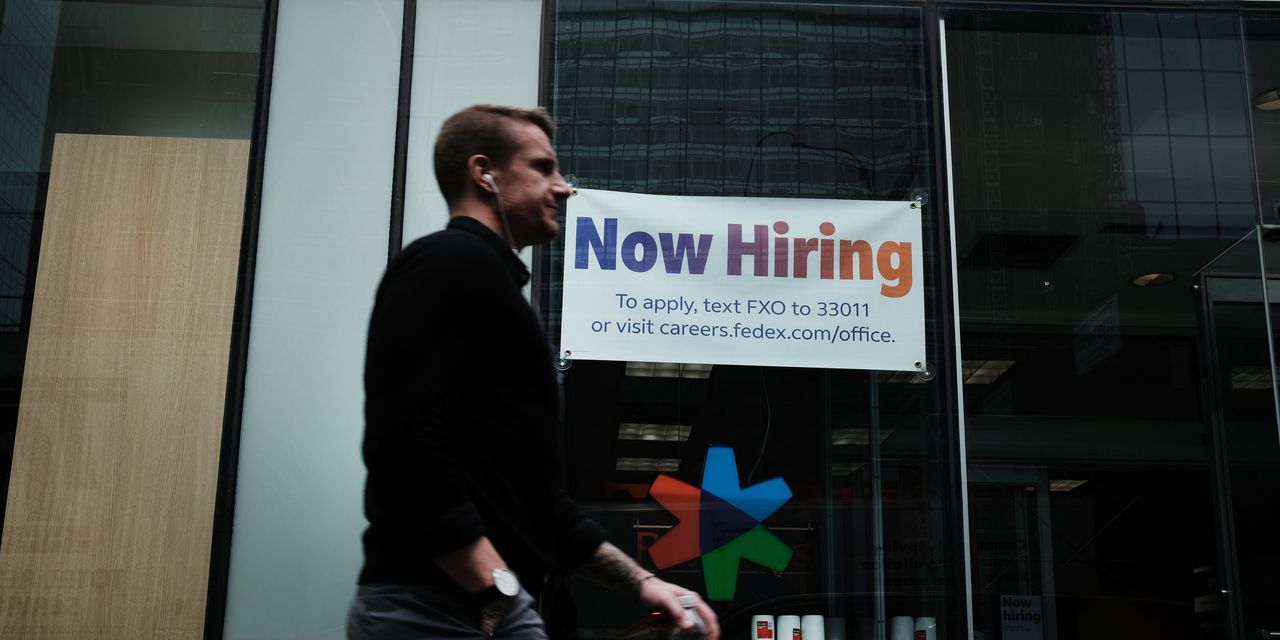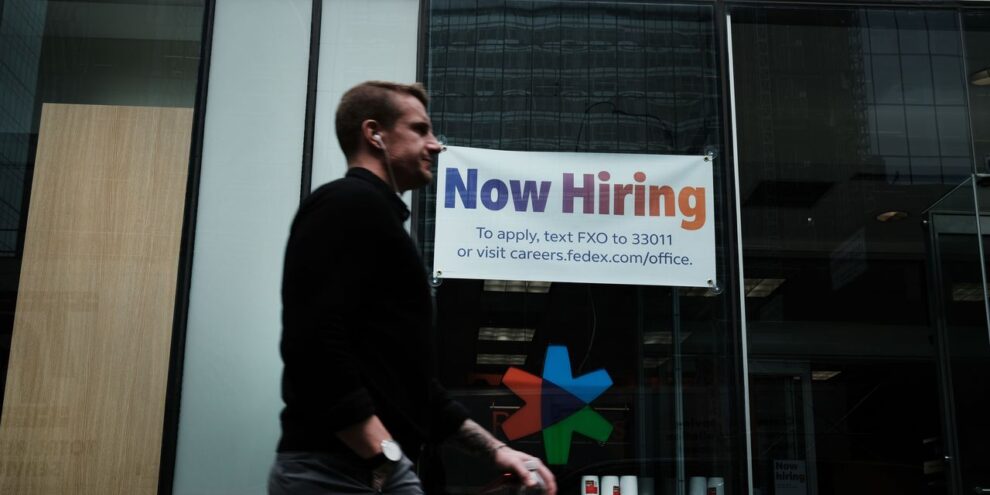
All three major U.S. stock benchmarks closed higher Friday, after a March jobs report reinforced a picture of a healthy economy but also underlined expectations for the Federal Reserve to be more aggressive in hiking interest rates in an effort to rein in persistently hot inflation.
How did stock indexes perform?
- The Dow Jones Industrial Average DJIA, +0.40% gained 139.92 points, or 0.4%, to close at 34,818.27.
- The S&P 500 SPX, +0.34% added 15.45 points, or 0.3%, to finish at 4,545.86.
- The Nasdaq Composite COMP, +0.29% rose 40.98 points, or 0.3%, to end at 14,261.50.
On Thursday, the Dow tumbled 550.46 points, for a 1.6% decline. The S&P 500 saw a similar fall, while the Nasdaq Composite shed 1.5%. For the quarter, all three benchmarks logged the biggest percentage drops since the first quarter of 2020 — 4.6%, 4.9% and 9.1%, respectively.
For the week, the Dow fell 0.1%, while the S&P 500 rose 0.1% and the Nasdaq advanced 0.7%. The Dow snapped two straight weeks of gains while the S&P 500 and Nasdaq each advanced for a third straight week, according to Dow Jones Market Data.
What drove the markets?
Major U.S. stock benchmarks ended higher Friday, after a choppy trading session, as investors parsed jobs and manufacturing data against their expectations for the Federal Reserve’s future path of rate hikes.
The U.S. economy created a healthy 431,000 jobs in March and the unemployment rate fell to 3.6% from 3.8%. Economists polled by The Wall Street Journal had forecast a total payroll gain of 490,000 jobs in March, and a drop in the unemployment rate to 3.7% from 3.8%.
“It was a good report,” said Russell Price, chief economist at Ameriprise Financial, in a phone interview Friday. “It’s indicative of a healthy underlying economy.”
Hourly pay rose sharply, pushing the increase in the past 12 months to 5.6%, the highest rate since the early 1980s. Employment in January and February combined is 95,000 higher than previously reported, the Labor Department said.
“For the Fed, today’s report gives them little consolation. With wage growth running so high, inflation fears are only heating up. A 50 [basis point] hike at the next meeting is surely secured. The only question that really remains is how many more 50 bps moves there will be this year,” said Seema Shah, chief strategist at Principal Global Investors, in emailed comments.
See also: The U.S. jobs market is scorching hot. Here’s where the flames are highest
Ameriprise’s Price told MarketWatch that he would not be “surprised” to see the Federal Reserve raise its benchmark interest rate by 50 basis points in May to combat high inflation. Chicago Federal Reserve President Charles Evans said Friday he stills supports a path of steady rates hikes of 25 basis points until next March.
Treasury yields rose after the jobs data was released, with the yield on the 2-year note moving back above the 10-year rate, inverting that measure of the yield curve. That measure inverted briefly earlier this week. A sustained inversion is viewed by many economists and market watchers as a reliable recession warning sign, albeit with a lag of up to a year or more.
Price said that he does not expect a recession in 2022 or 2023, “primarily because consumer finances are so strong.”
Read: What stock-market investors need to know about the bond market’s recession signal
In other U.S. economic data Friday, the S&P Global US Manufacturing
Purchasing Managers’ Index final reading for March was 58.8, up from 57.3 in February. The improvement in the health of the U.S. manufacturing sector was steep overall and the sharpest since last September, said Chris Williamson, chief business economist at S&P Global.
However, the Institute for Supply Management’s manufacturing PMI, a closely followed index of U.S.-based factory activity, slipped to 57.1% in March from 58.6% a month earlier, the research group said, its lowest reading since September 2020. Economists polled by The Wall Street Journal had forecast a slight improvement to 59%.
“Is the demand for manufactured goods finally slowing?” said Price, pointing to the drop in new orders. “We might be at a point where supply of manufactured goods is finally catching up with demand.”
Investors also kept close watch on the war in Ukraine, as negotiators from both sides were expected to hold talks via videoconference on Friday. Russia blocked a humanitarian aid convoy from reaching embattled Mariupol, as eastern Ukraine braced for more attacks.
The stock market may be “exhaling” after having “a pretty good March” and being “within shouting distance” from an all-time high despite geopolitical concerns and hot inflation, said Dave Grecsek, managing director in investment strategy and research at Aspiriant, in a phone interview Friday. The S&P 500 ended Friday 5.2% off its record close on Jan. 3, according to Dow Jones Market Data.
Considering the stock market’s current level, the Russia-Ukraine war and expectations for the Fed to potentially become more aggressive hiking rates to fight high inflation, “that’s not a good setup to really incentivize risk-taking,” said Grecsek.
Which companies were in focus?
- U.S. listed Chinese stocks surged on a report China authorities will give U.S. regulators full access to auditing reports. Shares of DiDi Global Inc. DIDI, +12.80% jumped 12.8%, while Bilibili Inc. BILI, +7.97%, Pinduoduo Inc. PDD, +6.33%, iQIYI Inc. IQ, +5.29%, Alibaba Group Holding Ltd. BABA, +1.29% and NIO Inc. NIO, +4.18% also saw solid gains in their stock prices.
- Shares of GameStop Corp. GME, -0.95% fell about 1% after the company said it was looking to conduct a stock split for the first time in 15 years.
How did other assets fare?
- The yield on the 10-year Treasury note rose 5 basis points Friday to 2.374%. For the week, the 10-year yield dropped 11.7 basis points, the largest weekly decline since the stretch ending March 4 , based on 3 pm Eastern Time levels, according to Dow Jones Market Data. Treasury yields and prices move in opposite directions.
- The ICE U.S. Dollar Index DXY, +0.26%, a measure of the currency against a basket of six major rivals, was up 0.3% on Friday but showed a weekly decline of 0.2%.
- In oil futures, West Texas Intermediate crude for May delivery CLK22, -0.86% fell 1% to settle at $99.27 a barrel, the lowest finish since March 16.
- Gold futures ended lower, with gold for June delivery GCM22, -1.31% falling nearly 1.6% to settle at $1,923.70 an ounce.
- Bitcoin BTCUSD, +0.88% was up around 1.3% at $46,341.
- In European equities, the Stoxx Europe 600 SXXP, +0.54% closed 0.5% higher Friday and climbed 1.1% for the week. London’s FTSE 100 UKX, +0.30% rose 0.3% Friday for a weekly gain of 0.7%.
- In Asia, the Shanghai Composite SHCOMP, +0.94% closed 0.9% higher Friday, bringing its weekly gain to 2.2%. The Hang Seng Index HSI, +0.19% rose 0.2% Friday, advancing 3% for the week. Japan’s Nikkei 225 NIK, -0.56% fell 0.6% Friday and booked a weekly decline of 1.7%.
—Barbara Kollmeyer contributed to this report.






